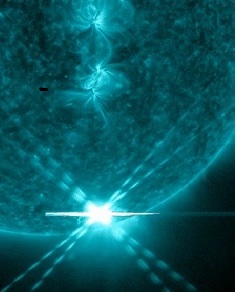The sun: our astrophysical accelerator laboratory
 The Sun is the most prolific accelerator of particles in the solar system, able to rapidly increase a particle’s energy by many orders of magnitude.
The Sun is the most prolific accelerator of particles in the solar system, able to rapidly increase a particle’s energy by many orders of magnitude.
Such impulsive bursts of energy (solar flares) produce intense radiation and power space weather. Yet we do not understand many basic properties of the physical processes involved or the specific conditions that trigger the onset and control the evolution of the acceleration.
Our approach
As the Sun is our closest star we are able to carefully study particle acceleration in solar flares using both ground and space-based telescopes with unprecedented spatial and temporal resolutions. The rapid energy release in flares results in emission that covers a wide spectral range from radio, through optical, to X-rays and gamma-rays, and reveals the accelerated particle spectrum.
Using detailed observations, the latest data analysis techniques and advanced computational simulations, Glasgow researchers are leading international collaborations to deduce the underlying energy release and acceleration processes.
Why is this research important?
Understanding how energy is released and particles accelerated in the Sun informs us not only about the mechanisms behind solar flares but also fundamental plasma and high energy processes throughout the universe. These processes are ubiquitous, from black holes in distant galaxies to fusion laboratories on Earth, which are trying to recreate the power source of the Sun and stars to provide a future renewable energy resource.

